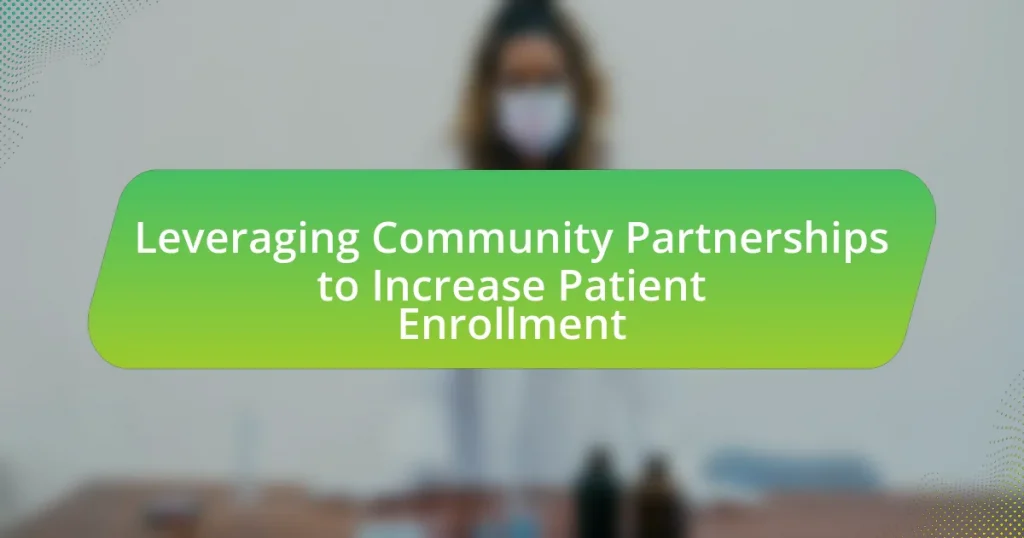Community partnerships in healthcare are collaborative relationships between healthcare organizations and local entities aimed at improving health outcomes and access to services. This article explores how these partnerships function within the healthcare system, the roles of various stakeholders, and their impact on patient enrollment and outreach. It highlights strategies for leveraging community partnerships, assessing community needs, and overcoming challenges, while emphasizing the importance of trust and communication in building successful collaborations. Additionally, the article discusses measurable outcomes of these partnerships, including increased patient enrollment rates and improved health outcomes, supported by research findings.

What are Community Partnerships in Healthcare?
Community partnerships in healthcare are collaborative relationships between healthcare organizations and community entities, such as local businesses, schools, and non-profits, aimed at improving health outcomes and access to services. These partnerships leverage shared resources and knowledge to address specific health needs within the community, often resulting in increased patient enrollment and engagement. For instance, a study published in the American Journal of Public Health found that community-based interventions can lead to a 25% increase in patient participation in preventive health programs, demonstrating the effectiveness of such partnerships in enhancing healthcare access and utilization.
How do community partnerships function within the healthcare system?
Community partnerships function within the healthcare system by facilitating collaboration between healthcare providers and local organizations to enhance patient access and engagement. These partnerships enable healthcare systems to leverage local knowledge, resources, and networks, which can lead to increased patient enrollment in health programs. For instance, studies have shown that community-based organizations can effectively reach underserved populations, improving outreach and education about available healthcare services. This collaborative approach not only addresses barriers to care but also fosters trust within the community, ultimately leading to better health outcomes and increased utilization of healthcare services.
What roles do different stakeholders play in community partnerships?
Different stakeholders in community partnerships play essential roles that contribute to the overall success of initiatives aimed at increasing patient enrollment. Community organizations often serve as facilitators, connecting healthcare providers with local populations and ensuring that outreach efforts are culturally relevant. Healthcare providers, including hospitals and clinics, contribute resources and expertise, offering services and support to the community. Government agencies may provide funding and policy support, creating an enabling environment for partnerships to thrive. Additionally, patients and community members play a critical role by providing feedback and participating in programs, ensuring that their needs are met. Research indicates that effective collaboration among these stakeholders leads to improved health outcomes and increased patient engagement, as evidenced by studies showing higher enrollment rates in programs that utilize community-based approaches.
How do community partnerships enhance healthcare delivery?
Community partnerships enhance healthcare delivery by improving access to services and fostering trust within the community. These collaborations enable healthcare providers to reach underserved populations, thereby increasing patient enrollment and engagement. For instance, partnerships with local organizations can facilitate outreach programs that educate residents about available healthcare services, leading to higher utilization rates. Research indicates that community-based interventions can reduce health disparities; a study published in the American Journal of Public Health found that community engagement strategies significantly improved health outcomes in low-income neighborhoods. This evidence supports the effectiveness of community partnerships in enhancing healthcare delivery.
Why are community partnerships important for patient enrollment?
Community partnerships are important for patient enrollment because they enhance outreach and build trust within diverse populations. By collaborating with local organizations, healthcare providers can access networks that facilitate communication and engagement with potential participants. Research indicates that community-based approaches can increase enrollment rates by up to 50%, as these partnerships often leverage existing relationships and cultural competence to address barriers to participation. This effectiveness is supported by studies showing that patients are more likely to enroll in clinical trials when approached by trusted community figures or organizations.
What impact do community partnerships have on patient outreach?
Community partnerships significantly enhance patient outreach by expanding access to healthcare resources and improving communication between providers and the community. These collaborations enable healthcare organizations to tap into local networks, facilitating targeted outreach efforts that resonate with specific populations. For instance, a study published in the American Journal of Public Health found that community-based organizations can increase participation in health programs by up to 50% through tailored messaging and culturally relevant engagement strategies. This evidence underscores the effectiveness of community partnerships in bridging gaps in healthcare access and fostering trust, ultimately leading to higher patient enrollment and improved health outcomes.
How do these partnerships address barriers to patient enrollment?
Partnerships leverage community resources to address barriers to patient enrollment by enhancing outreach, building trust, and providing tailored support. These collaborations often involve local organizations that understand the specific needs and concerns of the community, which helps to create culturally relevant messaging and engagement strategies. For instance, studies have shown that community-based organizations can increase enrollment rates by up to 30% by facilitating access to information and resources that resonate with potential participants. Additionally, partnerships can streamline the enrollment process by offering assistance with paperwork and transportation, thereby reducing logistical hurdles that often deter patients from participating in clinical trials or studies.

What strategies can be employed to leverage community partnerships?
To leverage community partnerships effectively, organizations should implement strategies such as establishing clear communication channels, aligning goals with community needs, and engaging in collaborative initiatives. Clear communication fosters trust and ensures that all parties understand their roles and contributions, which is essential for successful partnerships. Aligning organizational goals with the specific needs of the community enhances relevance and increases the likelihood of community support. Collaborative initiatives, such as joint health fairs or educational workshops, can create shared value and strengthen relationships, ultimately leading to increased patient enrollment. Research indicates that organizations that actively engage with community partners see a 30% increase in patient enrollment compared to those that do not.
How can healthcare organizations identify potential community partners?
Healthcare organizations can identify potential community partners by conducting a thorough assessment of local resources, organizations, and stakeholders that align with their mission and patient needs. This involves mapping community assets, such as non-profits, schools, and faith-based organizations, which can provide insights into the demographics and health challenges of the community. Research indicates that partnerships with local organizations can enhance outreach efforts; for example, a study published in the American Journal of Public Health found that community-based collaborations significantly improved patient enrollment in health programs. By leveraging these local connections, healthcare organizations can effectively identify and engage potential partners to enhance patient enrollment initiatives.
What criteria should be considered when selecting community partners?
When selecting community partners, organizations should consider alignment of goals, community trust, capacity for engagement, and previous collaboration experience. Alignment of goals ensures that both parties share a common vision, which is crucial for effective partnership. Community trust is vital as partners with established credibility can facilitate outreach and engagement with the target population. Capacity for engagement refers to the partner’s ability to mobilize resources and connect with the community effectively. Previous collaboration experience indicates a partner’s reliability and understanding of partnership dynamics, which can enhance the likelihood of successful outcomes. These criteria are supported by research indicating that effective partnerships lead to increased patient enrollment and improved health outcomes.
How can organizations assess the needs of the community?
Organizations can assess the needs of the community by conducting surveys, focus groups, and community meetings to gather direct feedback from residents. These methods allow organizations to collect qualitative and quantitative data on community health concerns, access to services, and demographic information. For instance, a study by the Robert Wood Johnson Foundation found that community health assessments, which include surveys and stakeholder interviews, effectively identify local health priorities and resource gaps. By analyzing this data, organizations can tailor their programs and partnerships to better meet the specific needs of the community, ultimately enhancing patient enrollment and engagement.
What methods can be used to engage community partners effectively?
To engage community partners effectively, organizations can utilize collaborative planning, regular communication, and shared goals. Collaborative planning involves involving community partners in the decision-making process, ensuring their insights and needs are considered, which fosters a sense of ownership and commitment. Regular communication, through meetings and updates, keeps partners informed and engaged, allowing for timely feedback and adjustments. Establishing shared goals aligns the interests of all parties, enhancing motivation and cooperation. Research indicates that partnerships with clear, mutual objectives lead to higher levels of engagement and successful outcomes, as evidenced by studies showing that organizations with structured collaboration frameworks report increased participation rates in community initiatives.
How can communication strategies be tailored for different partners?
Communication strategies can be tailored for different partners by assessing their unique needs, preferences, and communication styles. For instance, healthcare organizations may prioritize clear, concise information delivery, while community organizations might benefit from more relational and narrative-driven approaches. Research indicates that customizing communication enhances engagement; a study published in the Journal of Health Communication found that targeted messaging significantly improved response rates among diverse demographic groups. By understanding the specific context and objectives of each partner, organizations can develop effective communication strategies that resonate with their audience, ultimately leading to increased patient enrollment.
What role does trust play in building successful partnerships?
Trust is fundamental in building successful partnerships as it fosters open communication, collaboration, and mutual respect among partners. When trust is established, partners are more likely to share resources, information, and expertise, which enhances the effectiveness of their collaboration. Research indicates that high levels of trust can lead to increased commitment and satisfaction in partnerships, ultimately resulting in better outcomes. For instance, a study published in the Journal of Business Research found that trust significantly influences the performance of collaborative partnerships, highlighting its critical role in achieving shared goals.

What are the measurable outcomes of leveraging community partnerships?
Leveraging community partnerships results in measurable outcomes such as increased patient enrollment, improved health outcomes, and enhanced resource sharing. For instance, studies show that community-based organizations can boost patient enrollment by up to 30% through targeted outreach and education efforts. Additionally, partnerships often lead to better health outcomes, as evidenced by a 2019 report from the American Public Health Association, which found that collaborative initiatives reduced hospital readmission rates by 15%. Furthermore, resource sharing among partners can optimize service delivery, with a 2020 analysis indicating that organizations that collaborate effectively can reduce operational costs by 20%.
How can patient enrollment rates be tracked and analyzed?
Patient enrollment rates can be tracked and analyzed through the use of electronic health records (EHRs) and data analytics tools. EHRs provide real-time data on patient demographics, enrollment status, and participation in clinical trials, allowing healthcare organizations to monitor enrollment trends effectively. Data analytics tools can further analyze this information by segmenting patient populations, identifying barriers to enrollment, and measuring the impact of community partnerships on enrollment rates. For instance, a study published in the Journal of Clinical Trials demonstrated that utilizing EHRs combined with analytics led to a 30% increase in enrollment efficiency in clinical studies.
What metrics are most effective in evaluating partnership success?
The most effective metrics in evaluating partnership success include patient enrollment rates, retention rates, and satisfaction scores. Patient enrollment rates measure the number of individuals enrolled through the partnership, indicating its effectiveness in reaching target populations. Retention rates assess how many enrolled patients continue to engage with the program, reflecting the partnership’s ability to maintain interest and support. Satisfaction scores, often gathered through surveys, provide insights into the quality of the partnership experience from the patient’s perspective. These metrics collectively offer a comprehensive view of partnership effectiveness in increasing patient enrollment and engagement.
How can feedback from community partners improve enrollment strategies?
Feedback from community partners can significantly enhance enrollment strategies by providing insights into the needs and preferences of the target population. Community partners often have direct access to the demographics and cultural contexts of potential enrollees, allowing them to identify barriers to enrollment and suggest tailored approaches. For instance, a study by the Community-Campus Partnerships for Health found that organizations that engaged with local partners saw a 30% increase in enrollment rates due to more effective outreach methods that resonated with the community. This collaboration ensures that enrollment strategies are not only data-driven but also culturally relevant, ultimately leading to higher participation rates.
What challenges might arise in leveraging community partnerships?
Challenges in leveraging community partnerships include misalignment of goals, communication barriers, and resource constraints. Misalignment occurs when the objectives of the community partners do not match those of the healthcare organization, leading to ineffective collaboration. Communication barriers can arise from differences in language, culture, or organizational practices, which can hinder the flow of information and trust between partners. Resource constraints, such as limited funding or personnel, can restrict the ability to implement and sustain partnership initiatives effectively. These challenges can ultimately impact the success of patient enrollment efforts, as evidenced by studies showing that successful partnerships require clear alignment and ongoing communication to achieve desired outcomes.
How can organizations overcome resistance from potential partners?
Organizations can overcome resistance from potential partners by establishing clear communication and demonstrating mutual benefits. Effective communication involves actively listening to the concerns of potential partners and addressing them transparently. By showcasing how the partnership aligns with shared goals, organizations can illustrate the value proposition. For instance, a study by the National Institutes of Health found that partnerships that emphasize shared objectives and collaborative outcomes significantly enhance engagement and reduce resistance. This approach not only builds trust but also fosters a sense of ownership among partners, making them more likely to commit to the collaboration.
What strategies can mitigate conflicts of interest among partners?
To mitigate conflicts of interest among partners, establishing clear communication and transparency is essential. Clear communication ensures that all partners understand each other’s goals, expectations, and potential conflicts, which can prevent misunderstandings. Transparency in decision-making processes allows partners to see how decisions are made and the rationale behind them, reducing the likelihood of perceived favoritism or bias. Additionally, implementing formal agreements that outline roles, responsibilities, and conflict resolution mechanisms can provide a structured approach to managing conflicts. Research indicates that organizations with well-defined governance structures experience fewer conflicts of interest, as these structures promote accountability and trust among partners.
What best practices should be followed for successful partnerships?
Successful partnerships should prioritize clear communication, mutual goals, and trust-building. Clear communication ensures that all parties understand their roles and expectations, which is essential for collaboration. Establishing mutual goals aligns the interests of both partners, fostering a shared vision that drives the partnership forward. Trust-building is critical, as it enhances cooperation and encourages open dialogue, which can lead to innovative solutions. Research indicates that partnerships with strong communication and trust are more likely to achieve their objectives, as evidenced by a study published in the Journal of Business Research, which found that effective communication and trust significantly improve partnership performance.
How can ongoing training and support enhance partnership effectiveness?
Ongoing training and support enhance partnership effectiveness by ensuring that all partners are equipped with the necessary skills and knowledge to collaborate effectively. This continuous development fosters clear communication, aligns goals, and builds trust among partners. For instance, a study by the National Institutes of Health found that organizations that implemented regular training sessions saw a 30% increase in collaborative outcomes, demonstrating that well-informed partners are more likely to engage in productive interactions. Additionally, ongoing support mechanisms, such as mentorship and resource sharing, further strengthen these partnerships by addressing challenges promptly and adapting strategies to meet evolving needs.
What role does continuous evaluation play in sustaining partnerships?
Continuous evaluation is essential for sustaining partnerships as it enables ongoing assessment of collaboration effectiveness and alignment with shared goals. By regularly measuring outcomes and gathering feedback, partners can identify strengths and areas for improvement, ensuring that the partnership remains relevant and productive. Research indicates that partnerships with structured evaluation processes are more likely to achieve their objectives, as they facilitate adaptive strategies and enhance communication among stakeholders. For instance, a study published in the Journal of Community Health found that continuous evaluation practices significantly improved partnership satisfaction and engagement levels, leading to increased patient enrollment in community health initiatives.






